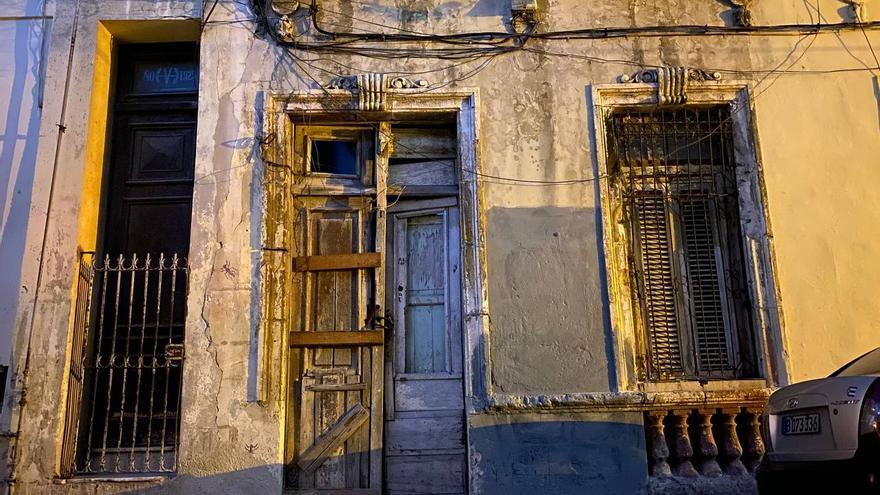
![]() 14ymedio, Luz Escobar, Havana, 26 November 2021 — A padlock permanently closes the two wooden panels of the 955 Damas Street door in Old Havana, which in the past was almost always open. According to many in the neighborhood, at the home of Luis Manuel Otero Alcántara and headquarters of the San Isidro Movement (MSI), “they always welcomed anyone.” Now, his figure is no longer visible in the doorway or leaning out the window as before. Since the protests of July 11, the artist has been held in a high security prison.
14ymedio, Luz Escobar, Havana, 26 November 2021 — A padlock permanently closes the two wooden panels of the 955 Damas Street door in Old Havana, which in the past was almost always open. According to many in the neighborhood, at the home of Luis Manuel Otero Alcántara and headquarters of the San Isidro Movement (MSI), “they always welcomed anyone.” Now, his figure is no longer visible in the doorway or leaning out the window as before. Since the protests of July 11, the artist has been held in a high security prison.
A year has passed since the violent eviction carried out by State Security to remove the group of hunger strikers and their companions from the property, who were demanding the freedom of rapper Denis Solís, and the outlook is now quite different.
This Thursday, November 25, Damas Street was passable, not like a year ago when police surveillance prevented it. From a staircase, music is heard at full volume, a Karol G song coming from the speakers. On the corner, a couple of boys fix a car, another cleans the roof of his pedicab while a young man charges his electric motorcycle.
“The block has been returning to normal,” says a neighbor. “I remember that in those days this was hell, even for us who lived here, they had us under control. The police and the officers had everyone scared, with threats, so that no one would get near Luis Manuel. But they could never screw up the relationship that that boy had with everyone. Here we adore him. He always said that what was his, belonged to everyone.”
The neighbor, who asked to remain anonymous, insistently compliments Otero Alcántara’s generosity. “It was tremendous, the neighbors felt that this was also their home. They passed by, talked, even took food
from the refrigerator if they needed it and ’Luisma’ said not to ask for permission.”
Solidarity, he argues, went both ways. “His neighbor also gave him food made almost daily. If he made beans, he would bring him some, as if they were family. He made himself known as he is and I tell you something: it is impossible not to love him.”
The neighbor relates that State Security managed to terrorize the area. Long before — and after – -the eviction on November 26, the artist lived harassed and persecuted by the authorities. Upon leaving the Manuel Fajardo Hospital where he was taken that night after several days on a hunger and thirst strike, he found his home besieged by police patrols and State Security officers, who from then on exercised 24-hour a day surveillance.
The government’s violent action against the MSI headquarters unleashed, the following day, an unprecedented protest by citizens, artists and intellectuals at the doors of the Ministry of Culture demanding that freedom of expression and the right to have rights be respected. Where will we meet? What do we do? Where are we going? Were the questions that ran through the WhatsApp groups that was immediately created to coordinate a meeting on November 27.
Faced with the outrage and violence that many had seen on their cell phone screens, the reaction was to take to the streets, that place that in Cuba is reserved only for “revolutionaries”, according to President Miguel Díaz-Canel himself said during the day of protests on July 11, when Otero Alcántara ended up in prison again, where he has not yet left.
“When Luis Manuel was there, we felt safe, his brave attitude was contagious.” That is why, he says, on April 4 “the whole block” came out to sing Patria y Vida and shout “Díaz-Canel singao [motherficker]” in “the face of the Police” and helped prevent the arrest of Maykel Castillo Osorbo.
Now, “with him in prison, everything is different, there is no one who defends us from the abuses of the Police and it’s quiet here,” he laments.
Another neighbor on the block says that Otero Alcántara went to live with an aunt in El Cerro and almost did not return to Damas Street when he left Calixto García Hospital, where he was in custody for a month after another hunger strike he carried out.
“He just came to get some things and left quickly, because here there was the fixed guard of the State Security and the police patrol cars on the corner,” says the woman. “It is very hard what that boy has lived through, the only thing he does is art.”
A relative of the artist who spoke with 14ymedio remembers that the last time he visited him in prison, Otero Alcántara told him: “Living here has taught me that nothing belongs to anyone, if you want to watch a movie on television and the one who’s bigger and stronger wants to watch the ballgame, that’s what you have to watch.”
Although the artist was laughing as he said it, the relative did not have the courage to answer what he was thinking: “It is 955 Damas Street that is your house, Luis Manuel, not this dungeon where they have put you.”
____________
COLLABORATE WITH OUR WORK: The 14ymedio team is committed to practicing serious journalism that reflects Cuba’s reality in all its depth. Thank you for joining us on this long journey. We invite you to continue supporting us by becoming a member of 14ymedio now. Together we can continue transforming journalism in Cuba.
